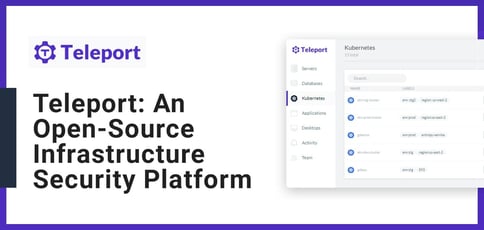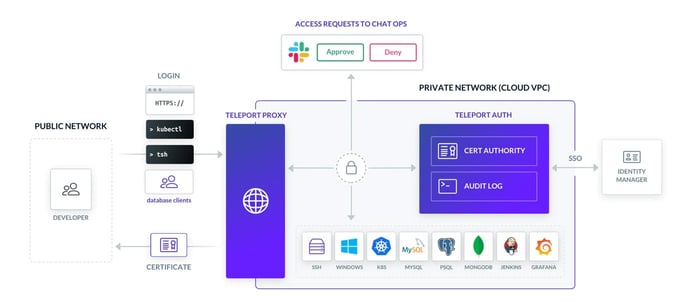
TL; DR: Teleport is an open-source platform that allows developers to quickly access their computing infrastructure from one dashboard. The company addresses growing infrastructure complexity while finding ways to reduce costs for clients. Its Teleport Access Plane platform boosts visibility and accessibility, and Teleport is working to help non-developer clients safeguard vulnerable devices.
The founders of Teleport, an open-source platform built to enable software engineers to access infrastructure, are self-professed technology geeks. They had launched other tech businesses but wanted to develop Teleport as an open-source solution to keep their computing infrastructure safe from malicious attacks. That security has become one of the most critical components of the technology sector.
“Teleport was started by people similar to myself in that we are basically infrastructure geeks, hardware geeks, and Linux kernel geeks,” said Teleport CEO Ev Kontsevoy. “We love making life easier for people who also love infrastructure.”

Teleport allows engineers to access computing resources from anywhere globally through a single intuitive interface. Its founders saw the challenges presented by leveraging disparate systems independently.
The founders realized environments included many layers of resources, and each came with its own trust model. Network boundaries burdened with excessive configuration typically separate those platforms. That complexity slowed developers down and led to human errors, which led to inadequate security across all fronts.
“We witnessed the transition of programming from one machine to many and eventually to cloud computing,” reads the company’s origin story on its website. “This brought enormous complexities into our lives. Half of our effort now goes toward erecting and continuously maintaining complex ‘cloud environments’ for our programs.”
Making Sense of Complex Hardware Components
Teleport set out to address how complexity led to safety vulnerabilities.
“If our own engineers need to fix something the customer is experiencing, how do we manage access to all of these things?” Ev said.
Teleport also aimed to solve another pain point for businesses: the cost of managing infrastructure. That price has been steadily increasing for decades.
“If you look at budgets allocated to DevOps teams, they keep growing faster than anything else in research and development,” Ev said. “Over time, we’re getting better at building software, but it’s also getting more expensive to run it because of that complexity.”

The company created a secure access product, the Teleport Access Plane, that allows developers to see everything in one place. The plane works with SSH, RDP, MongoDB, MySQL, Postgres, and Kubernetes, among other platforms. That means a single point of access, which is easier to secure.
“By consolidating all aspects of infrastructure access into a single platform, Teleport reduces attack surface area, cuts operational overhead, easily enforces compliance, and improves productivity,” reads a post on the company’s website. “The Teleport Access Plane replaces VPNs, shared credentials, and legacy privileged access management technologies, improving security and engineering productivity.”
Clients have seen plenty of success using that approach, and Teleport now works with companies including Airtable, DoorDash, Samsung, and Twitch, among many others.
A Platform That Promotes Visibility and Accessibility
Ev said one recent trend Teleport noticed in the market is the cybersecurity mesh concept. It means having a singular vulnerability point instead of a broader range of access ports.
“The idea is, instead of setting up access for each thing, you need to have an architecture where all access — connectivity, security, authentication, authorization, audit — are concentrated in one place,” Ev said. “From there, it gets propagated into the individual server, resource, or layer of your stack.”
According to Ev, when companies do that properly, they can open up firewalls and allow the external world to access their network because all of their resources are secured properly. That is a trend that organizations across many industries are currently trying to implement.
That helps Teleport clients maximize visibility. The other significant component is accessibility. Ev said the open-source nature is critical to Teleport’s business and technology mode.
“This is simply because most people, especially hobbyists, students, or small teams, don’t have the budget for enterprise solutions,” Ev said. “And they could just go and build their own using open-source tools, which we tried to enable.”
Teleport is poised to play a critical role in moving toward more cohesive infrastructure security. And the technology industry continues to move in the same direction.
The company also continues to go the extra mile when it comes to security, according to Ev. That approach can help enterprise teams that often need to scale infrastructure quickly.
“Sure, every software development team wants to move fast. But we have many checks and balances put into place to make sure that Teleport is secure and reliable,” he said. “If Teleport is compromised, or if Teleport stops working, getting cut off from your entire infrastructure is not what you want. That’s why we have an extremely challenging interview process to get on my team.”
Teleport also has a rigorous process for submitting code for acceptance and production. The company hires external auditors to go line-by-line through any code set for release. It also publishes the results of those audits, which is rare in the industry.
Teleport: Reducing Client-Side Vulnerabilities
The Teleport team just launched its latest release, and it was an exciting one. Ev told us that, until recently, Teleport was a Linux-based solution that worked with Linux, Kubernetes, MongoDB, MySQL, Postgres, and others.
“But the latest Teleport version actually introduced support for Windows,” Ev said.
He said the team is very excited about it because of the creative way the solution implements Windows support.
“We provide you with a first-class experience accessing Windows hosts inside a web browser,” Ev said. “So that’s been a recent release that many people are excited about.”
Next, Teleport is looking to focus more on client-side solutions rather than just products aimed at developers.
“If your laptop is stolen, that is certainly a vulnerability, right? So what do you do to protect against that? Or if your laptop is hacked? How do you make sure that that laptop cannot be used as an attack vector to the rest of the infrastructure?” Ev said.
“It will be easier moving forward because now laptops, phones, and tablets have biometric authentication, including built-in features like face recognition and fingerprints,” he said.
Ev said Teleport plans to leverage its expertise to make those authentication tools are even more robust.
“And on the server-side, we expect to support more protocols and layers of your technology stack,” Ev told us. “We want to support absolutely everything you need to access if you are accessing anything inside of a datacenter.”


